KIA Sportage 2006 JE_ / 2.G Owner's Manual
Manufacturer: KIA, Model Year: 2006, Model line: Sportage, Model: KIA Sportage 2006 JE_ / 2.GPages: 354, PDF Size: 3.62 MB
Page 111 of 354
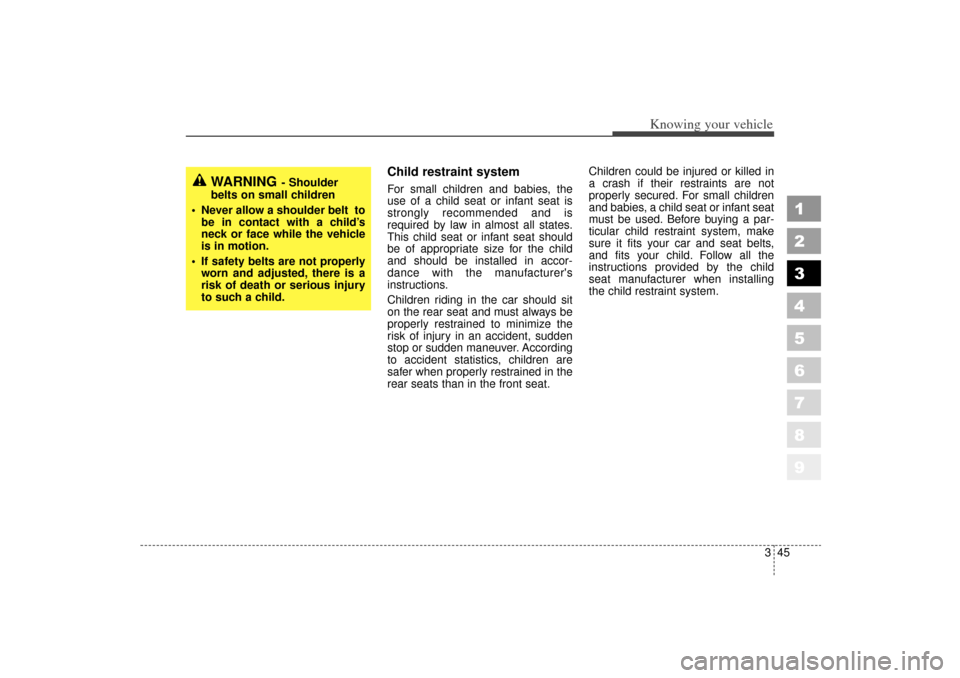
345
Knowing your vehicle
1
2
3
4
5
6
7
8
9
Child restraint system For small children and babies, the
use of a child seat or infant seat is
strongly recommended and is
required by law in almost all states.
This child seat or infant seat should
be of appropriate size for the child
and should be installed in accor-
dance with the manufacturer's
instructions.
Children riding in the car should sit
on the rear seat and must always be
properly restrained to minimize the
risk of injury in an accident, sudden
stop or sudden maneuver. According
to accident statistics, children are
safer when properly restrained in the
rear seats than in the front seat.Children could be injured or killed in
a crash if their restraints are not
properly secured. For small children
and babies, a child seat or infant seat
must be used. Before buying a par-
ticular child restraint system, make
sure it fits your car and seat belts,
and fits your child. Follow all the
instructions provided by the child
seat manufacturer when installing
the child restraint system.
WARNING
- Shoulder
belts on small children
Never allow a shoulder belt to be in contact with a child’s
neck or face while the vehicle
is in motion.
If safety belts are not properly worn and adjusted, there is a
risk of death or serious injury
to such a child.
KM CAN (ENG) 3 (~54)new.qxd 7/29/05 9:33 AM Page 45
Page 112 of 354
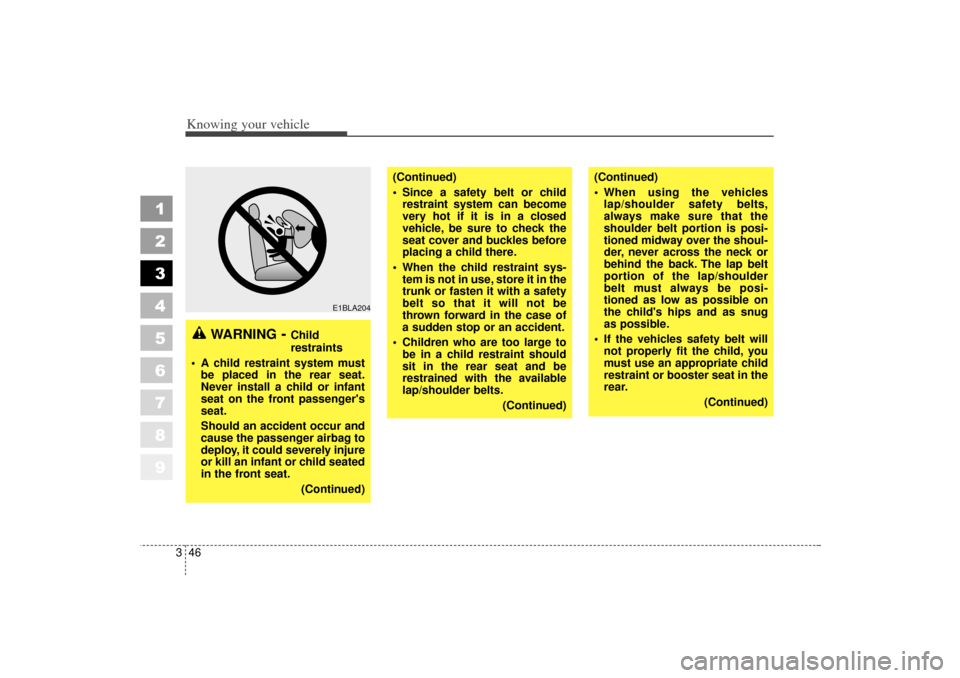
Knowing your vehicle46
3
1
2
3
4
5
6
7
8
9
WARNING
- Child
restraints
A child restraint system must be placed in the rear seat.
Never install a child or infant
seat on the front passenger's
seat.
Should an accident occur and
cause the passenger airbag to
deploy, it could severely injure
or kill an infant or child seated
in the front seat.
(Continued)
(Continued)
When using the vehicleslap/shoulder safety belts,
always make sure that the
shoulder belt portion is posi-
tioned midway over the shoul-
der, never across the neck or
behind the back. The lap belt
portion of the lap/shoulder
belt must always be posi-
tioned as low as possible on
the child's hips and as snug
as possible.
If the vehicles safety belt will not properly fit the child, you
must use an appropriate child
restraint or booster seat in the
rear.
(Continued)
(Continued)
Since a safety belt or childrestraint system can become
very hot if it is in a closed
vehicle, be sure to check the
seat cover and buckles before
placing a child there.
When the child restraint sys- tem is not in use, store it in the
trunk or fasten it with a safety
belt so that it will not be
thrown forward in the case of
a sudden stop or an accident.
Children who are too large to be in a child restraint should
sit in the rear seat and be
restrained with the available
lap/shoulder belts.
(Continued)
E1BLA204
KM CAN (ENG) 3 (~54)new.qxd 7/29/05 9:33 AM Page 46
Page 113 of 354
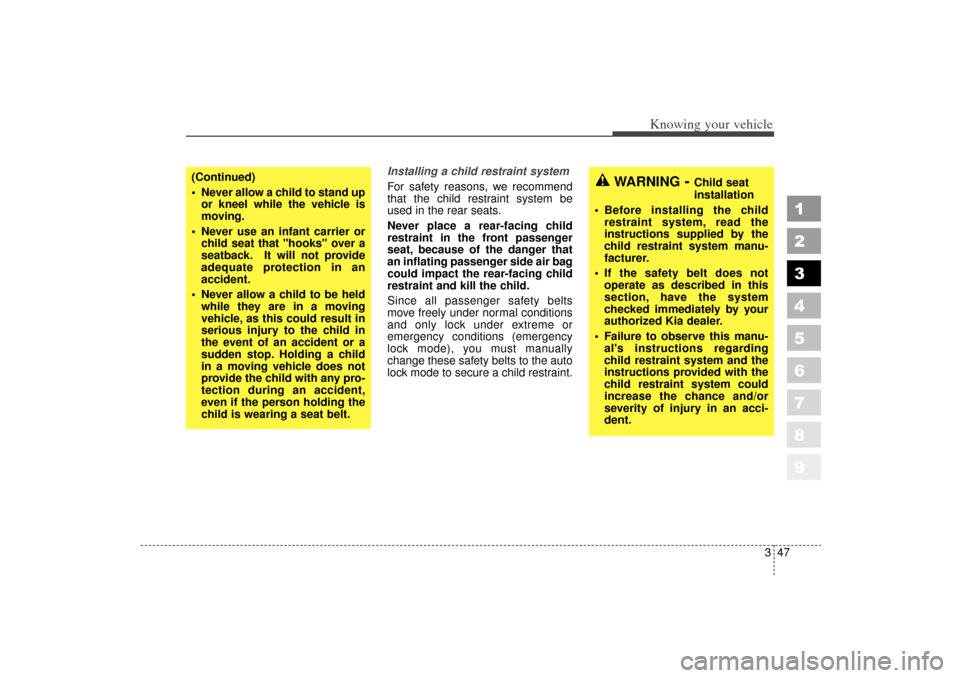
347
Knowing your vehicle
1
2
3
4
5
6
7
8
9
Installing a child restraint system
For safety reasons, we recommend
that the child restraint system be
used in the rear seats.
Never place a rear-facing child
restraint in the front passenger
seat, because of the danger that
an inflating passenger side air bag
could impact the rear-facing child
restraint and kill the child.
Since all passenger safety belts
move freely under normal conditions
and only lock under extreme or
emergency conditions (emergency
lock mode), you must manually
change these safety belts to the auto
lock mode to secure a child restraint.
(Continued)
Never allow a child to stand upor kneel while the vehicle is
moving.
Never use an infant carrier or child seat that "hooks" over a
seatback. It will not provide
adequate protection in an
accident.
Never allow a child to be held while they are in a moving
vehicle, as this could result in
serious injury to the child in
the event of an accident or a
sudden stop. Holding a child
in a moving vehicle does not
provide the child with any pro-
tection during an accident,
even if the person holding the
child is wearing a seat belt.
WARNING
- Child seat
installation
Before installing the child restraint system, read the
instructions supplied by the
child restraint system manu-
facturer.
If the safety belt does not operate as described in this
section, have the system
checked immediately by your
authorized Kia dealer.
Failure to observe this manu- al's instructions regarding
child restraint system and the
instructions provided with the
child restraint system could
increase the chance and/or
severity of injury in an acci-
dent.
KM CAN (ENG) 3 (~54)new.qxd 7/29/05 9:33 AM Page 47
Page 114 of 354
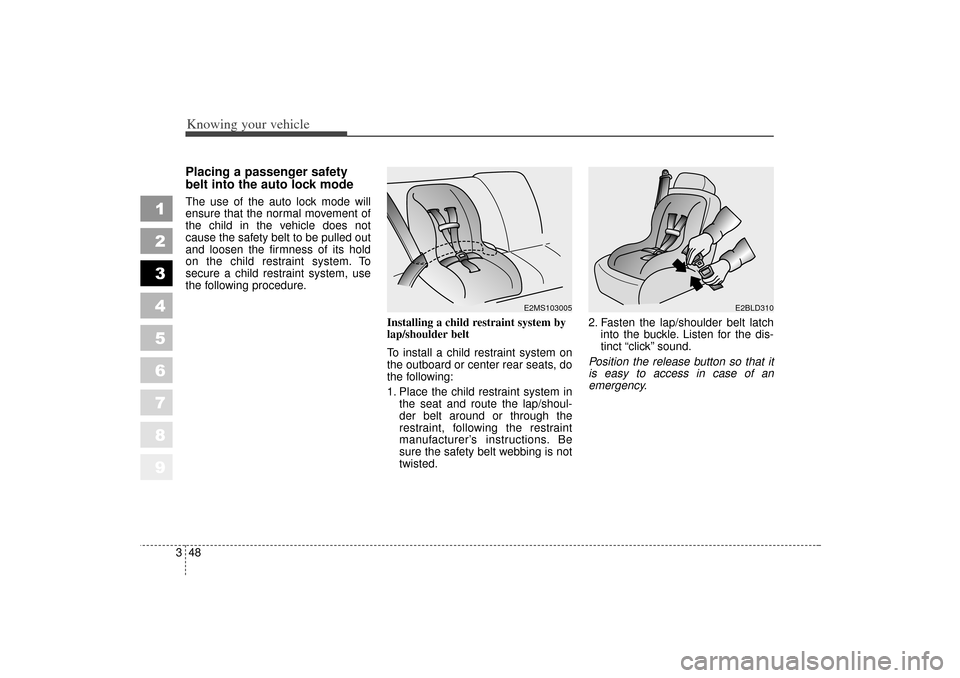
Knowing your vehicle48
3
1
2
3
4
5
6
7
8
9
Placing a passenger safety
belt into the auto lock modeThe use of the auto lock mode will
ensure that the normal movement of
the child in the vehicle does not
cause the safety belt to be pulled out
and loosen the firmness of its hold
on the child restraint system. To
secure a child restraint system, use
the following procedure.
Installing a child restraint system by
lap/shoulder belt
To install a child restraint system on
the outboard or center rear seats, do
the following:
1. Place the child restraint system inthe seat and route the lap/shoul-
der belt around or through the
restraint, following the restraint
manufacturer’s instructions. Be
sure the safety belt webbing is not
twisted. 2. Fasten the lap/shoulder belt latch
into the buckle. Listen for the dis-
tinct “click” sound.
Position the release button so that it
is easy to access in case of an
emergency.
E2MS103005
E2BLD310
KM CAN (ENG) 3 (~54)new.qxd 7/29/05 9:33 AM Page 48
Page 115 of 354
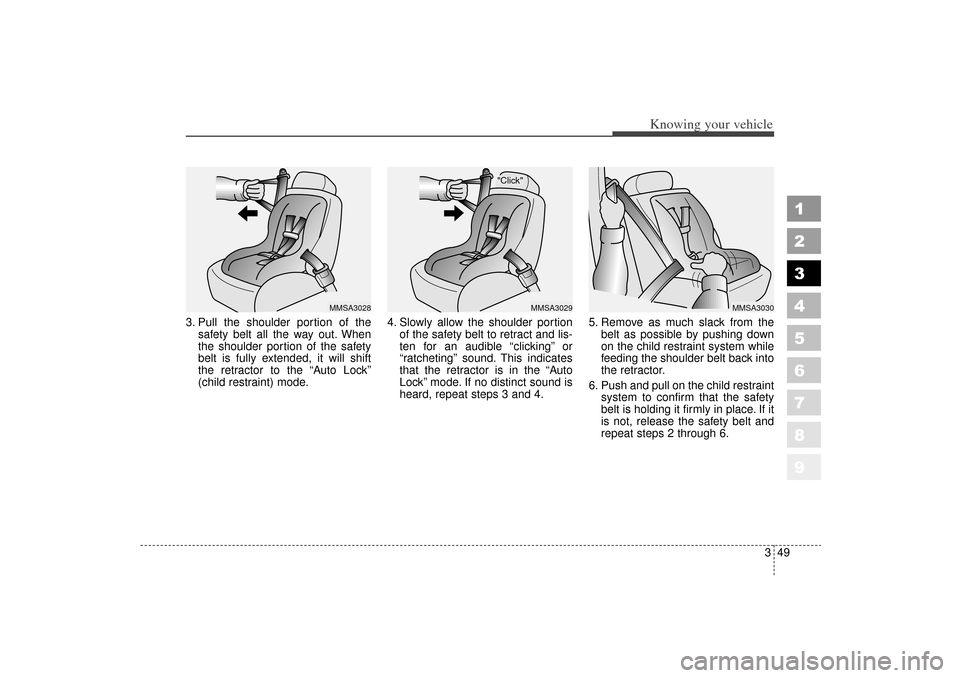
349
Knowing your vehicle
1
2
3
4
5
6
7
8
9
3. Pull the shoulder portion of thesafety belt all the way out. When
the shoulder portion of the safety
belt is fully extended, it will shift
the retractor to the “Auto Lock”
(child restraint) mode. 4. Slowly allow the shoulder portion
of the safety belt to retract and lis-
ten for an audible “clicking” or
“ratcheting” sound. This indicates
that the retractor is in the “Auto
Lock” mode. If no distinct sound is
heard, repeat steps 3 and 4. 5. Remove as much slack from the
belt as possible by pushing down
on the child restraint system while
feeding the shoulder belt back into
the retractor.
6. Push and pull on the child restraint system to confirm that the safety
belt is holding it firmly in place. If it
is not, release the safety belt and
repeat steps 2 through 6.
"Click"
MMSA3029
MMSA3028
MMSA3030
KM CAN (ENG) 3 (~54)new.qxd 7/29/05 9:33 AM Page 49
Page 116 of 354
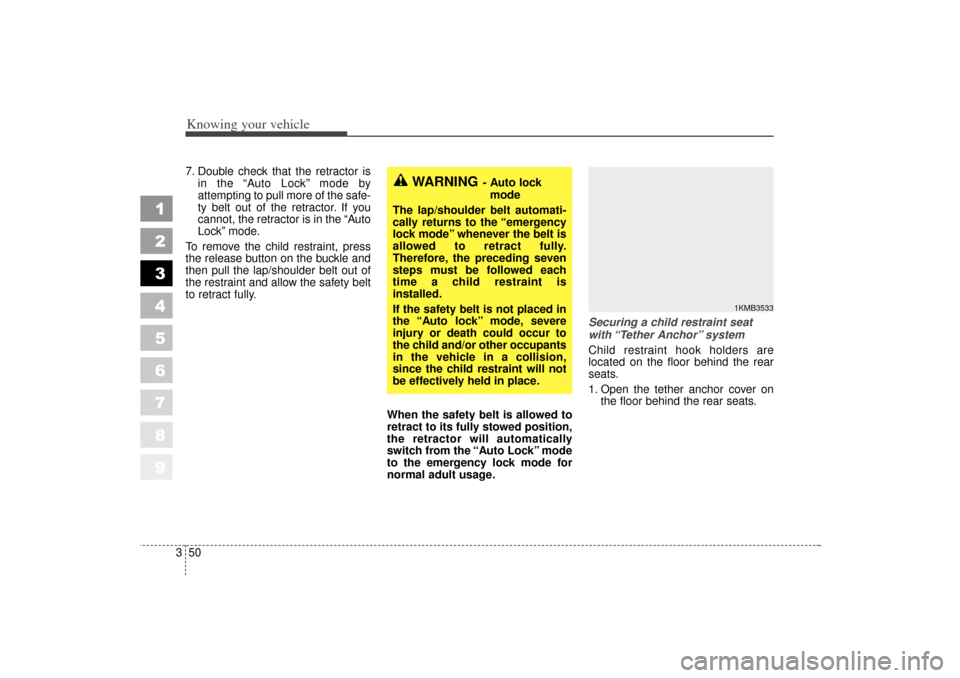
Knowing your vehicle50
3
1
2
3
4
5
6
7
8
9
7. Double check that the retractor is
in the “Auto Lock” mode by
attempting to pull more of the safe-
ty belt out of the retractor. If you
cannot, the retractor is in the “Auto
Lock” mode.
To remove the child restraint, press
the release button on the buckle and
then pull the lap/shoulder belt out of
the restraint and allow the safety belt
to retract fully.
When the safety belt is allowed to
retract to its fully stowed position,
the retractor will automatically
switch from the “Auto Lock” mode
to the emergency lock mode for
normal adult usage.Securing a child restraint seat
with “Tether Anchor” system
Child restraint hook holders are
located on the floor behind the rear
seats.
1. Open the tether anchor cover on
the floor behind the rear seats.
WARNING
- Auto lock
mode
The lap/shoulder belt automati-
cally returns to the “emergency
lock mode” whenever the belt is
allowed to retract fully.
Therefore, the preceding seven
steps must be followed each
time a child restraint is
installed.
If the safety belt is not placed in
the “Auto lock” mode, severe
injury or death could occur to
the child and/or other occupants
in the vehicle in a collision,
since the child restraint will not
be effectively held in place.
1KMB3533
KM CAN (ENG) 3 (~54)new.qxd 7/29/05 9:33 AM Page 50
Page 117 of 354
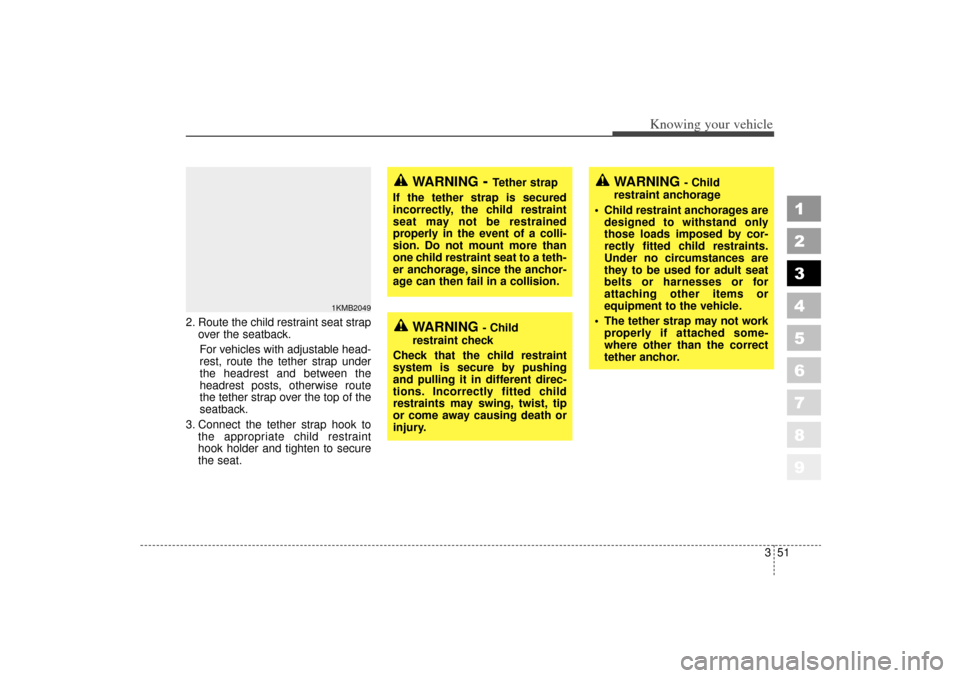
351
Knowing your vehicle
1
2
3
4
5
6
7
8
9
2. Route the child restraint seat strapover the seatback.
For vehicles with adjustable head-
rest, route the tether strap under
the headrest and between the
headrest posts, otherwise route
the tether strap over the top of the
seatback.
3. Connect the tether strap hook to the appropriate child restraint
hook holder and tighten to secure
the seat.
1KMB2049
WARNING
- Tether strap
If the tether strap is secured
incorrectly, the child restraint
seat may not be restrained
properly in the event of a colli-
sion. Do not mount more than
one child restraint seat to a teth-
er anchorage, since the anchor-
age can then fail in a collision.
WARNING
- Child
restraint check
Check that the child restraint
system is secure by pushing
and pulling it in different direc-
tions. Incorrectly fitted child
restraints may swing, twist, tip
or come away causing death or
injury.
WARNING
- Child
restraint anchorage
Child restraint anchorages are designed to withstand only
those loads imposed by cor-
rectly fitted child restraints.
Under no circumstances are
they to be used for adult seat
belts or harnesses or for
attaching other items or
equipment to the vehicle.
The tether strap may not work properly if attached some-
where other than the correct
tether anchor.
KM CAN (ENG) 3 (~54)new.qxd 7/29/05 9:33 AM Page 51
Page 118 of 354

Knowing your vehicle52
3
1
2
3
4
5
6
7
8
9
Child seat lower anchors
Some child seat manufacturers
make child restraint seats that are
labeled as International Standards
Organization Fixed (ISOFIX) or
ISOFIX-compatible child restraint
seats. These seats include two rigid
or webbing mounted attachments
that connect to two ISOFIX anchors
at specific seating positions in your
vehicle. This type of child restraint
seat eliminates the need to use seat
belts to attach the child seat for for-
ward-facing child restraint seats in
the rear seats. There is a symbol located on the
lower portion of each side of the rear
seatbacks. These symbols indicate
the position of the lower anchors for
child restraints so equipped.
ISOFIX anchors have been provided
in your vehicle. The ISOFIX anchors
are located in the left and right out-
board rear seating positions. Their
locations are shown in the illustra-
tion. There is no ISOFIX anchor pro-
vided for the center rear seating
position.
The ISOFIX anchors are located
between the seatback and the seat
cushion of the rear seat left and right
outboard seating positions.
1KMB3541
1KMB3542
1KMB3551
KM CAN (ENG) 3 (~54)new.qxd 7/29/05 9:33 AM Page 52
Page 119 of 354
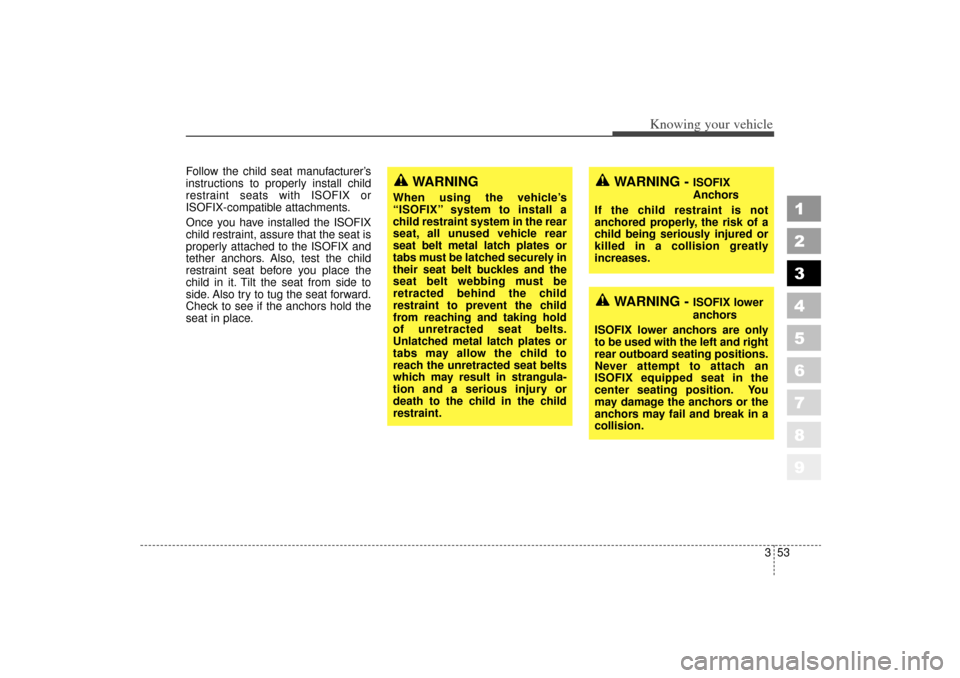
353
Knowing your vehicle
1
2
3
4
5
6
7
8
9
Follow the child seat manufacturer’s
instructions to properly install child
restraint seats with ISOFIX or
ISOFIX-compatible attachments.
Once you have installed the ISOFIX
child restraint, assure that the seat is
properly attached to the ISOFIX and
tether anchors. Also, test the child
restraint seat before you place the
child in it. Tilt the seat from side to
side. Also try to tug the seat forward.
Check to see if the anchors hold the
seat in place.
WARNING -
ISOFIX
Anchors
If the child restraint is not
anchored properly, the risk of a
child being seriously injured or
killed in a collision greatly
increases.
WARNING -
ISOFIX lower
anchors
ISOFIX lower anchors are only
to be used with the left and right
rear outboard seating positions.
Never attempt to attach an
ISOFIX equipped seat in the
center seating position. You
may damage the anchors or the
anchors may fail and break in a
collision.
WARNING
When using the vehicle’s
“ISOFIX” system to install a
child restraint system in the rear
seat, all unused vehicle rear
seat belt metal latch plates or
tabs must be latched securely in
their seat belt buckles and the
seat belt webbing must be
retracted behind the child
restraint to prevent the child
from reaching and taking hold
of unretracted seat belts.
Unlatched metal latch plates or
tabs may allow the child to
reach the unretracted seat belts
which may result in strangula-
tion and a serious injury or
death to the child in the child
restraint.
KM CAN (ENG) 3 (~54)new.qxd 7/29/05 9:33 AM Page 53
Page 120 of 354
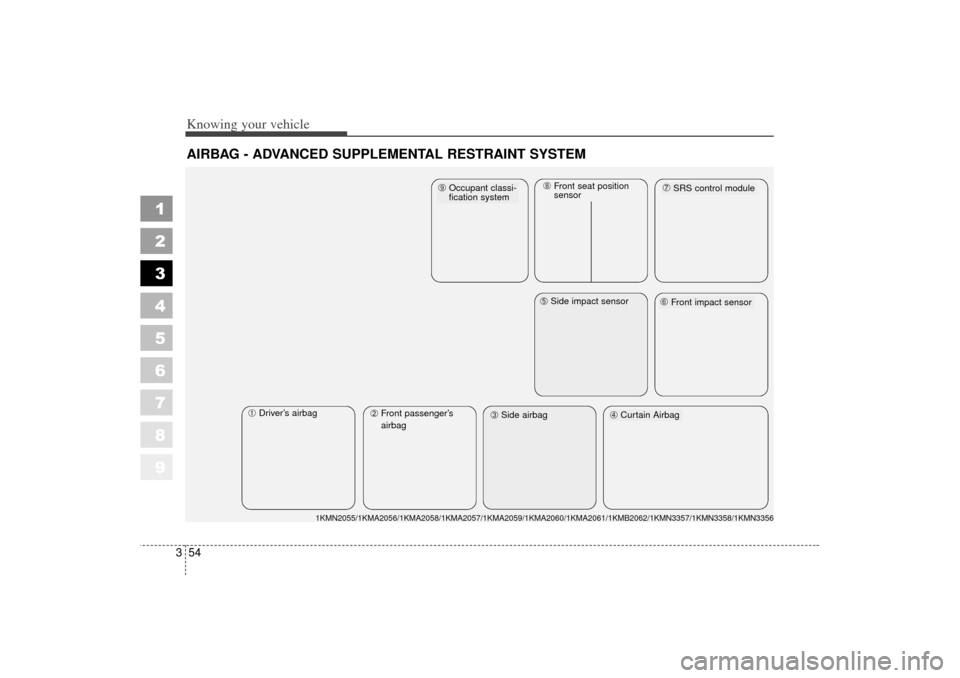
Knowing your vehicle54
3
1
2
3
4
5
6
7
8
9
AIRBAG - ADVANCED SUPPLEMENTAL RESTRAINT SYSTEM
➀Driver’ s airbag
➁Front passenger’ s
airbag
➃Curtain Airbag
\bFront impact sensor➆SRS control module
1KMN2055/1KMA2056/1KMA2058/1KMA2057/1KMA2059/1KMA2060/1KMA2061/1KMB2062/\
1KMN3357/1KMN3358/1KMN3356
➂Side airbag
➄Side impact sensor
➈Occupant classi-
fication system
➇Front seat position
sensor
KM CAN (ENG) 3 (~54)new.qxd 7/29/05 9:33 AM Page 54